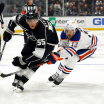Once the momentum started turning in favor of the Blue Jackets, the Lightning encountered more obstacles, making it more difficult to get back into the series.
Defenseman Victor Hedman, last season's Norris Trophy winner, was injured and missed Tampa Bay's final four regular-season games. He returned for the start of the playoffs but struggled in the first two games before sitting out Games 3 and 4. Anton Stralman, another top-four defenseman, missed all four games against Columbus.
By contrast, the top two defensemen for Columbus, Zach Werenski and Seth Jones, were impact players; they combined for nine points and each averaged more than 25 minutes of ice time per game.
Tampa Bay forward Nikita Kucherov, the NHL's scoring leader with 128 points (41 goals, 87 assists), was suspended for Game 3. Under normal circumstances, that might not have been a big deal for a team as deep as the Lightning. But after losing the first two games at home, the Lightning suddenly appeared more vulnerable than they had at any point during the season. Kucherov returned for Game 4; he finished with two assists and was minus-4 in the series.
Goalie Andrei Vasilevskiy had an .856 save percentage after winning 39 games and finishing with a .925 save percentage during the regular season. By comparison, Columbus goalie Sergei Bobrovsky had a .932 save percentage in the series, up from .913 during the regular season.
Finally, the Blue Jackets might have been stronger than a typical wild card team. They finished with 98 points, better than three playoff teams in the Western Conference, but appeared to underachieve during the season relative to the talent on their roster, even after deciding to add before the NHL Trade Deadline on Feb. 25. They did go 7-1-0 in their final eight regular-season games, outscoring opponents 34-14.
If it is a matter of the Blue Jackets putting it together at the right time, then they are a team that has the potential to win more than one round.
The other upset was different. The Islanders finished second in the Metropolitan Division, three points ahead of Pittsburgh. But the Penguins have the pedigree of playoff success, having won the Stanley Cup in 2016 and 2017.
As it was all season, goaltending was a big part of the first-round success for the Islanders. Robin Lehner had a sensational regular season, posting a .930 save percentage in 46 games. He was even better against the Penguins, finishing with a .956 save percentage in the four-game sweep.


















